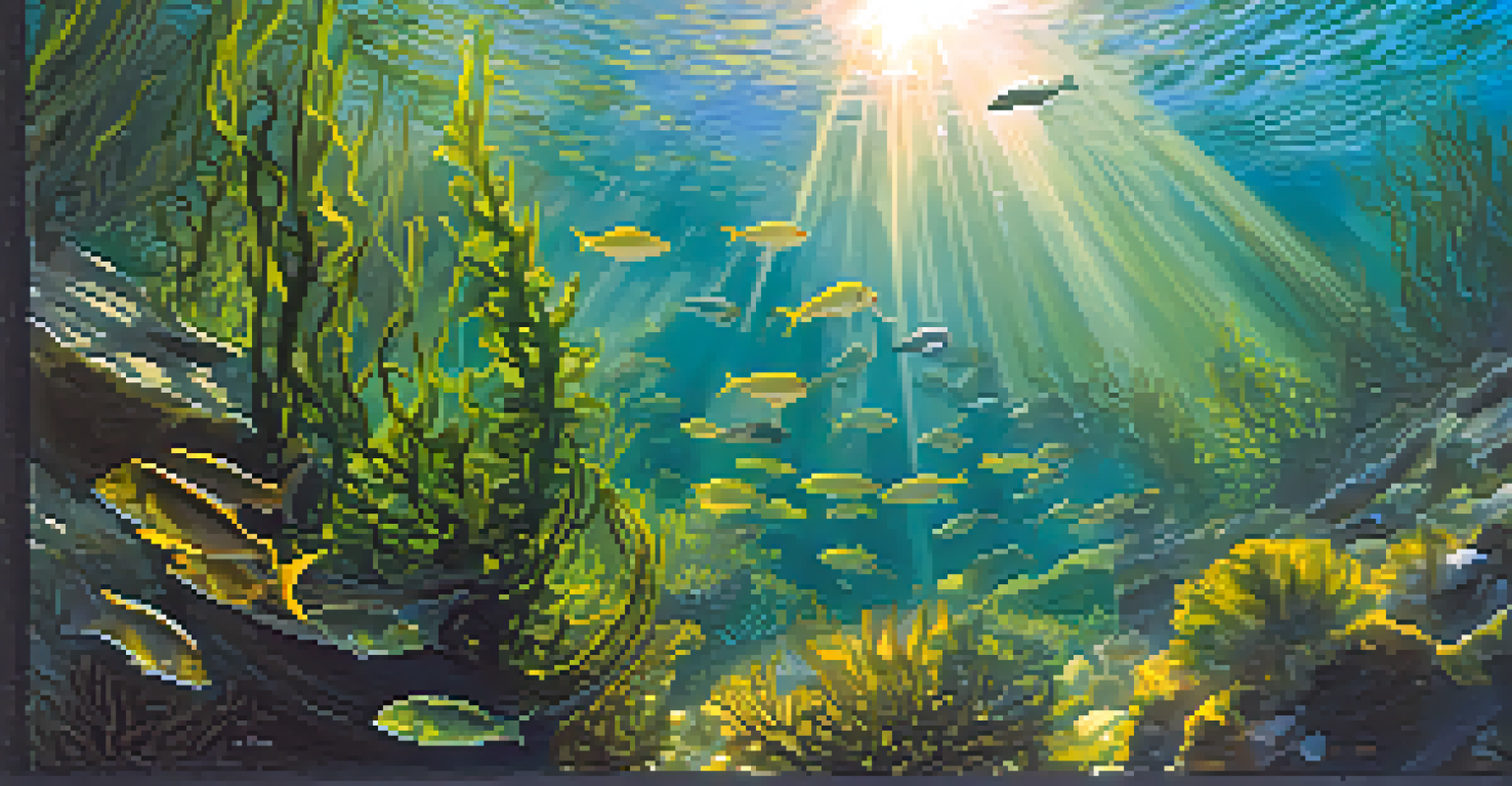The Impact of San Diego's Marine Protected Areas

Understanding Marine Protected Areas in San Diego
Marine Protected Areas (MPAs) are designated regions where human activity is limited to protect marine ecosystems. In San Diego, these areas have been established to conserve biodiversity and fish populations. By restricting activities like fishing and development, MPAs aim to allow marine life to thrive.
The future will either be green or not at all.
San Diego's coastline is home to a diverse array of marine species, making these protected areas essential for their survival. The MPAs cover various habitats, including kelp forests, rocky reefs, and sandy beaches, each serving as a sanctuary for different species. Understanding their purpose helps underscore the importance of these areas to local ecosystems.
The establishment of MPAs in San Diego reflects a growing recognition of the need to safeguard our oceans. These areas not only protect marine life but also promote sustainable practices among local communities. As we dive deeper into this topic, it’s clear that the impact of MPAs extends far beyond just the water.
Biodiversity Benefits of San Diego's MPAs
One of the most significant impacts of San Diego's MPAs is the increase in biodiversity. By limiting human interference, these areas provide a safe haven for various species to flourish. Healthy ecosystems support a wider range of marine life, ensuring the resilience of these underwater communities.

Research shows that MPAs can lead to an increase in fish populations and sizes, enhancing the overall health of marine ecosystems. For example, studies have indicated that fish species within protected areas often grow larger and reproduce more successfully. This growth not only benefits the species themselves but also the surrounding marine environment.
MPAs Boost Marine Biodiversity
San Diego's Marine Protected Areas enhance biodiversity by providing safe havens for various marine species to thrive.
Additionally, the boost in biodiversity has a positive ripple effect on the entire ecosystem. More diverse ecosystems are better equipped to withstand environmental pressures, such as climate change and pollution. This resilience is crucial for maintaining the balance of marine life in San Diego's waters.
Economic Impact on Local Communities
While MPAs are primarily focused on conservation, they also bring economic benefits to local communities. Healthy marine ecosystems can boost tourism, attracting visitors eager to explore San Diego's natural beauty. Activities such as snorkeling, diving, and whale watching thrive in areas with abundant marine life.
In every walk with nature one receives far more than he seeks.
Fisheries can also benefit from MPAs, as they help replenish fish stocks. By allowing fish populations to recover, local fishermen can enjoy more sustainable catches over time. This balance between conservation and economic viability is crucial for the long-term health of both marine life and local livelihoods.
Moreover, the presence of MPAs can create new job opportunities in eco-tourism and marine research. As awareness of these protected areas grows, so does the potential for community engagement and involvement in conservation efforts. This connection between the environment and the economy is a key aspect of San Diego's MPAs.
The Role of Education in Conservation Efforts
Education plays a vital role in the success of San Diego's MPAs. By informing the public about the importance of these protected areas, we can foster a culture of conservation. Schools, organizations, and local governments collaborate to raise awareness about marine ecosystems and their significance.
Educational programs often include hands-on activities like beach clean-ups and guided tours of marine habitats. These initiatives not only engage the community but also instill a sense of responsibility for protecting our oceans. When people understand the value of MPAs, they are more likely to advocate for their preservation.
Economic Benefits of MPAs
Marine Protected Areas support local economies by boosting tourism and replenishing fish stocks for sustainable fishing.
Furthermore, educational outreach can bridge the gap between scientists and the public. Sharing research findings and success stories from MPAs helps build trust and encourages community involvement. Together, we can work towards a sustainable future for San Diego's marine environments.
Challenges Facing San Diego's Marine Protected Areas
Despite their benefits, San Diego's MPAs face several challenges that threaten their effectiveness. One major issue is illegal fishing, which undermines the goals of conservation efforts. Enforcement of regulations is crucial to ensure that these areas remain protected and that marine life can thrive.
Another challenge is climate change, which poses significant threats to marine ecosystems. Rising sea temperatures and ocean acidification can disrupt the balance of marine life, making it difficult for MPAs to fulfill their purpose. Addressing these broader environmental issues requires collaboration among scientists, policymakers, and the community.
Public awareness is also essential in overcoming these challenges. The more informed people are about the importance of MPAs, the more likely they are to support conservation efforts. Engaging the community in discussions about the challenges facing marine protected areas can foster a collective commitment to their preservation.
Success Stories from San Diego's MPAs
San Diego's MPAs have produced several success stories that highlight their positive impact on marine life. For example, areas like the Point Loma MPA have seen a resurgence in local fish populations, drawing both researchers and recreational fishermen back to the waters. These success stories serve as a testament to the effectiveness of marine conservation.
Additionally, the return of species like the kelp forest ecosystem showcases the resilience of nature when given a chance to recover. These vibrant underwater forests not only support marine life but also play a crucial role in carbon sequestration. The thriving kelp forests are a clear indicator that MPAs can lead to significant ecological improvements.
Education Drives Conservation Success
Community education is essential for fostering public support and involvement in the conservation of San Diego's MPAs.
Sharing these success stories can inspire further conservation efforts, both locally and globally. They remind us that protecting our oceans is a worthy investment in the future of our planet. By highlighting these victories, we can motivate others to join the cause and advocate for marine protection.
Looking Ahead: The Future of MPAs in San Diego
The future of San Diego's MPAs looks promising, with ongoing research and community involvement poised to drive further success. As scientists continue to study the impacts of these protected areas, we can expect to see more data supporting their benefits. This research will be essential for shaping future conservation policies.
Community engagement remains a cornerstone of successful MPAs. As more residents participate in conservation efforts, the collective impact can lead to even greater protection for marine ecosystems. Building a sense of stewardship among the community is vital for the sustainability of these areas.

Ultimately, the future of San Diego's MPAs hinges on continued collaboration between scientists, policymakers, and the community. By working together, we can ensure that these protected areas remain a sanctuary for marine life and a resource for future generations. The journey toward a healthier ocean is ongoing, and every action counts.